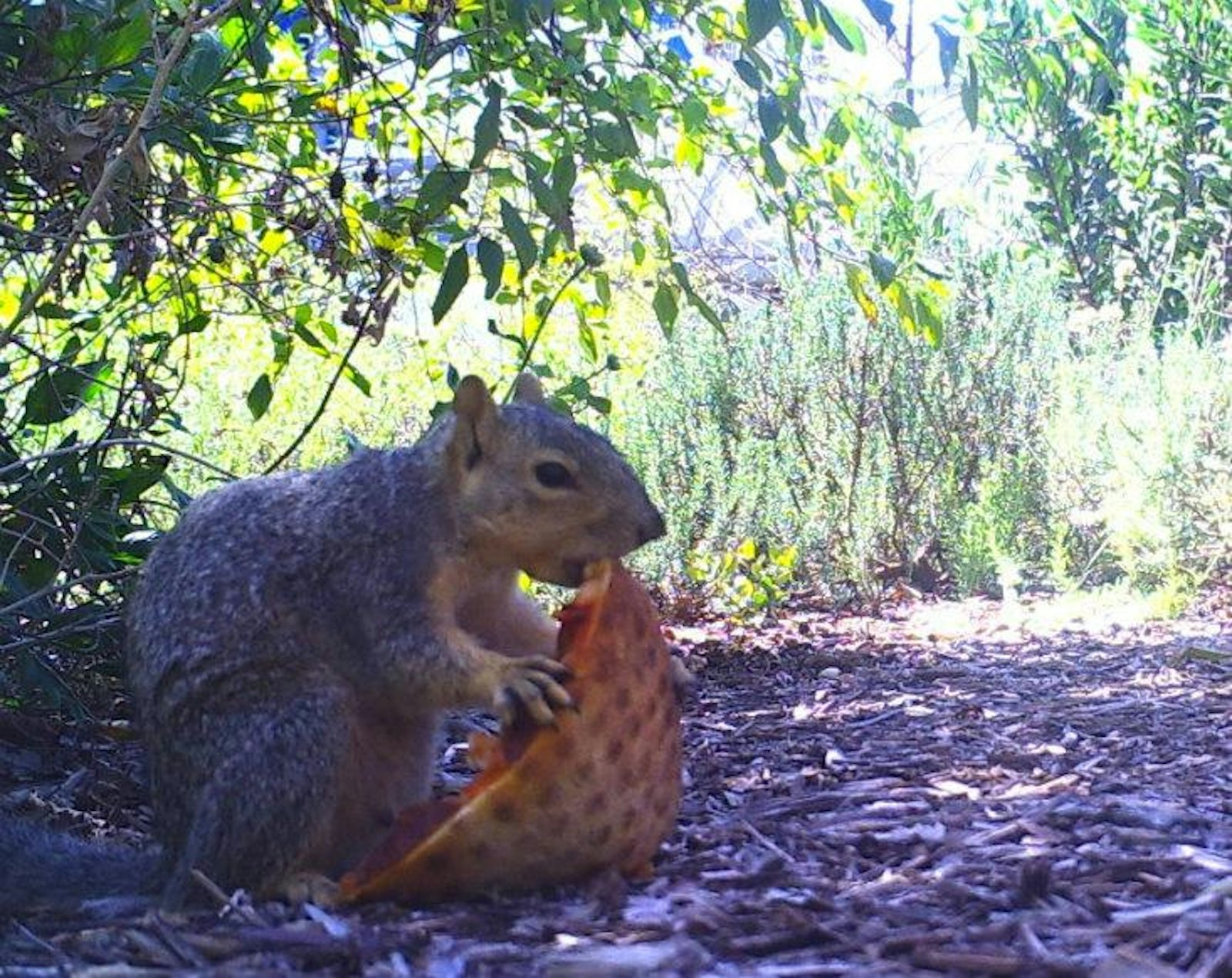
In West Los Angeles, just across the 405 freeway from UCLA, sits a hospital that’s been serving veterans for more than 100 years. Back in 1904, it housed veterans from the Civil and Spanish-American Wars and was called the “Sawtelle Veterans Home.” Many of the Civil War vets came from the American South, from places like Tennessee and Kentucky. At that time, Los Angeles was far less developed than it is now. Most of the city was still quite rural, mainly consisting of citrus orchards and walnut groves.
That much we know is true. What follows is perhaps at best described as legend, though it comes to me from a good source: Jim Dines, collections manager of mammalogy at the Natural History Museum in Los Angeles.
The Civil War vets kept eastern fox squirrels in much the same way people who are not farmers sometimes keep chickens: They were companions until the day they became food. The squirrels were kept in cages and eventually found their way into a squirrel stew, a meal the men used to enjoy back home. “The story goes that the hospital administrators, being government employees, were not comfortable with the animals being fed table scraps. These are government resources that are being used, and that’s not allowed,” Dines told me. “So they turned the squirrels lose, right there on the VA grounds.” And the squirrels took to Southern California quite well.
Unbeknownst to the hospital administrators, the eastern fox squirrel, Sciurus niger, is a born invader. They can survive just about anywhere, they reproduce quickly, and they’re willing to eat just about anything, from crops to bird fodder to discarded pizza crusts.
What started, circa 1904, as a small population of pet squirrels released on the grounds of the Sawtelle Veterans Home, had spread by the 1930s to the neighboring San Fernando Valley, where they found a smorgasbord of citrus fruits and walnuts, helpfully planted and maintained by local farmers. This is where legend ends and empirical data begins once more, thanks to county agriculture records. “There was probably a bounty on these squirrels, because they were causing havoc on the orchards,” Dines explains.
While researchers know that there was an introduction in the early 1900s at the Sawtelle Veterans Home, there have been other introduction events since then as well, though details are difficult to reconstruct since the importation of squirrels into California become illegal in 1933.
Eastern fox squirrels may have been introduced to Long Beach during the Second World War by Iowans who were sent to the area to work for the aerospace industry, according to biologist Julie King, who organized a citizen-science project (pdf) to help uncover the history of the squirrel invasion. Some of the Iowans trapped a handful of fox squirrels back home, brought them out West, and released them into several Long Beach-area parks as an antidote for homesickness.
There was also “the intentional introduction of two dozen fox squirrels relocated from Fresno by a board member of the Stockdale Country Club into the city of Bakersfield in 1985 even after he was repeatedly warned against it, [which] has subsequently resulted in hundreds of thousands of dollars of damage to homes throughout the city limits,” as reported by King.
Even wildlife experts, who you might think would be more careful, have assisted the invasive squirrels. Prior to 2002, when California instituted new release protocols, wildlife rehabilitation centers could release squirrels wherever they wanted, and they did. “Many were released,” King writes, “in areas of Los Angeles County not formerly inhabited by fox squirrels under the belief that they would do well there and have an increased chance for survival.”
Today, we might say the squirrels were engaging in misappropriation of government funds.
Now, more than one hundred years after their first introduction, the eastern fox squirrel has reached the outside boundaries of Los Angeles and beyond. If you live in LA and you see a squirrel in your backyard, it’s almost certainly an eastern fox squirrel. And it’s not only California: While the species’ native range covers much of the eastern half of the United States, it has successfully invaded much of the western half, including Washington, Oregon, Idaho, Montana, Wyoming, Colorado, New Mexico, and even British Columbia and Ontario, in Canada.
The fact that eastern fox squirrels are so flexible and resourceful is the most important reason they can survive in these new habitats. But their ability to invade the entire Los Angeles basin was largely due to the thousands of miles of aerial telephone cables criss-crossing the region, forming a squirrel-friendly highway system. It allowed them to avoid dogs, cats, and cars, squirrels’ primary enemies in cities, and also to colonize new areas.
For the last decade or so, the eastern fox squirrel’s spread has brought it snout-to-snout with LA’s native tree squirrel, the western grey, Sciurus griseus. Unlike the eastern fox, the western grey doesn’t do well in cities. They’re specialists, who rely upon the acorns and fungi that grow around the roots of native oak trees for food. While the eastern fox squirrels can set up camp wherever they like, they’re starting to set up camp in the same territory as the western greys.
Will the invaders edge the native squirrels out of their territories? Contrary to her predictions, King found that when there were aggressive interactions between the two species, it was the grey squirrels that usually started the fights, and it was the greys that usually won. If the greys lose, it isn’t because they’re giving up. But fox squirrels produce two litters of pups each year, while greys have one, meaning that the invading easterners can produce more troops, more quickly, than the defending westerners.
The battle is ongoing. Ten years ago, when King conducted her research, she concluded that “the differences in habitat preference and tolerance of human disturbance may allow them to co-exist for extended periods of time in suburban foothill habitats which may represent marginal habitats for both species.” But in 2009, researchers documented the rapid replacement of western grey squirrels by eastern fox squirrels on the campus of California State Polytechnic University, in Pomona, just outside of Los Angeles. The first documented sighting of the fox squirrel on the campus was May 17, 2005. In less than two years, grey squirrels went from ubiquitous to unseen. They have not been observed on the main quad of the campus since 2006, and campus surveys in 2008 and 2009 revealed just a single western grey squirrel—the same individual each time! The eastern fox squirrels, of course, are everywhere.
Based on this limited information, it appears as if the two species can coexist in habitats with sufficient resources, but in smaller spaces where resources might be lacking, the eastern fox squirrels quickly plant their flags, acquire new territory, and send the western greys packing.
King warns that as residential development continues in Southern California and oak forests are razed to make way for construction, the western grey squirrels will be forced to retreat further into the foothills, while the eastern fox squirrels follow the spread of Starbucks. If the western greys lose the mature oak trees they need to survive, their prospects seem dim, at least in the Los Angeles area.
A follow-up citizen-science study is currently being conducted by researchers at the Natural History Museum of Los Angeles. If you want to participate, visit the Southern California Squirrel Survey on iNaturalist.
Jason G. Goldman received his Ph.D. in developmental psychology at the University of Southern California in Los Angeles and writes a blog called The Thoughtful Animal, hosted at Scientific American. His doctoral research focused on the evolution and architecture of the mind, and how different early experiences might affect innate knowledge systems.


























